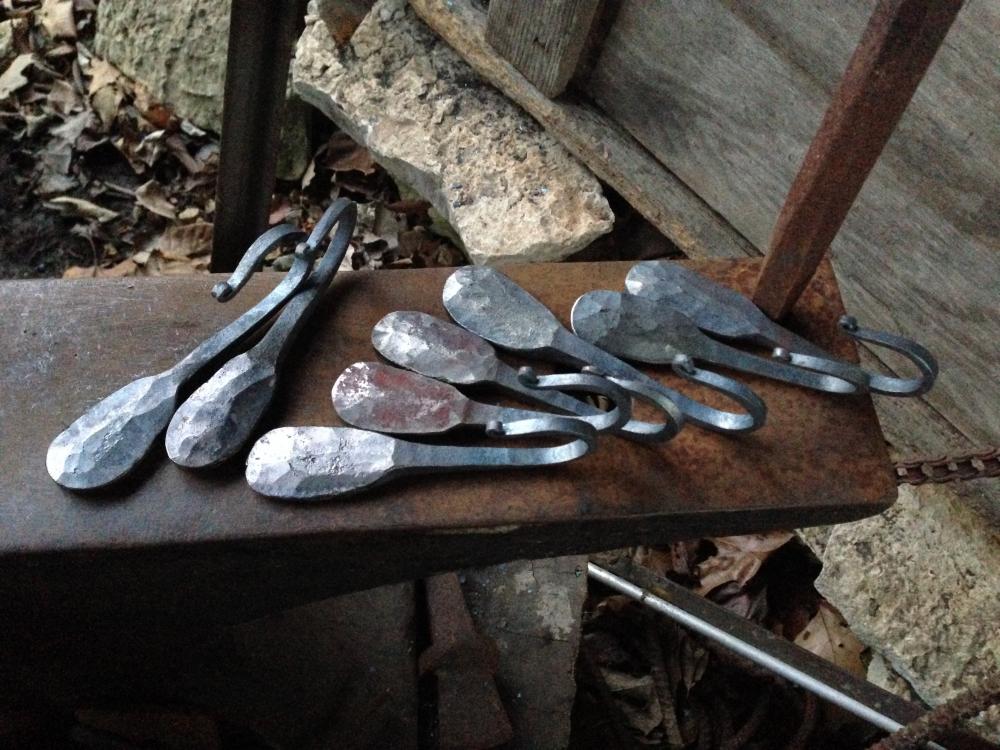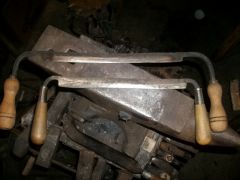
bigfootnampa
Members-
Posts
2,372 -
Joined
-
Last visited
Content Type
Profiles
Forums
Articles
Gallery
Downloads
Events
Everything posted by bigfootnampa
-
In practical terms, there is little advantage to using the more expensive cold rolled steel for forging stock! When the steel is to be used in fabrication without passing through the forge it could be a useful option. Of course, if you have cold rolled stock on hand there is no reason why you couldn't forge it and the price differential is fairly modest for small amounts.
-
MY own approach would be to taper the blanks BEFORE punching and drifting! You might want to try that on your next batch! Seems like there is the potential to mess up some of your nice work on the holes at this point.
-
Just sharing a quick tip from my own experience. I often drill rather than punching for screws or nails. To drill accurately I need a good center punch. Many of the ones that I have made have NOT held up well in use... requiring frequent regrinding. One notable exception is one that I made from an old star drill! I just ground a nice point on the fluted (drill) end! That's it! No heat treating. It stays sharp much longer than most of my center punches and makes a nice starting mark! There are a lot of these old drills available in the marketplaces! Grab a few!
-
The most common reason for drawing down stock is that it is much easier than upsetting, and tapers, shoulders, swellings, necks... etcetera are the basics of making attractive forged forms... if you only bend stock drawn forms, your work will be pretty limited in appeal... BORING, really! So making cross-sectional variations in stock is more easily and quickly done by drawing out than by upsetting!
-
You can rivet cold too! Tongs are normally too tight to open and close easily after riveting... EASY to fix... just heat them and work them while hot a few times!
-
If you are collecting some, the thicker ones are preferred as they are more versatile.
-
Actually most rotary mower blades that I have run across are about 1084 to 1090 carbon and will make very fine cutting tools... including knives! Limited sizes and the inconvenient holes are drawbacks. I sometimes run into some edge damage that is a bit of trouble to work around as well. None of the old blades that I have on hand are low carbon!
-
Ethan I can't imagine a cast iron header that would perform as well as a smith made one! Cast iron is MORE brittle and LESS flexible than good steel! Try one made from leaf spring or heavy coil spring! I have worn out a few headers, but NEVER broken one!
-
Stan that hammer style (your favorite) is called a Warrington pattern. English pattern I believe and not limited to smithing. In fact I first bought some, in very small sizes, from woodworking suppliers for assembling picture frames. I have reforged some of those big old ball peens to make good cross or straight peens. I usually drift out the handle slots first thing when I do this. The handle slots are almost always too small and not waisted just right!
-
Some Wall Hooks from RR Spikes!
bigfootnampa replied to bigfootnampa's topic in Blacksmithing, General Discussion
They won't be holding coats. Actually each corner has a small ground chamfer. It is hard to see in the pictures. -
Some Wall Hooks from RR Spikes!
bigfootnampa replied to bigfootnampa's topic in Blacksmithing, General Discussion
Frosty; I often do punch rather than drill. In this case I had plenty of metal as the pads are about 3/16" thick and drilling was faster and neater than punching. Time was a factor. These spike hooks are pretty soft to drill and countersink. Because the kitchen where they are mounted is kind of a clean modern look, I didn't think twists or rustic embellishments would be a good fit. I have made many leaves but didn't want these too complex or costly. I put a paint finish on them with Rust-Oleum's universal paint, burnished amber color. I like this paint! It forms a flexible film with strong bonding properties. -
Spear shaft sapling or split wood
bigfootnampa replied to Chance's topic in Spears, Arrows, Pole arms, Mace/hammer etc.
It depends partly on scale... I could have a spear shaft roughed out from a sapling in twenty minutes, with only a small hand axe and a knife to work with... Definitely what I'd do if I were on the march and needed one more spear for myself. Cutting a larger tree or two, riving and shaving, could be a whole days work... BUT, I'd end with at least a dozen shafts... what I'd do if I were outfitting part of an army! Also maybe some of both as I might use up the available supply of suitable saplings and still need more shafts. -
I made these for a customer who will mount them on an interior wall. Because the arrangement of the hooks will make it unlikely that they will locate over studs, I made these to be screw anchored so that standard drywall anchors can be used anywhere on the wall. These are forged and ground but will still need to be drilled and countersunk. Forged from old railroad spikes. I first made a 5" nail then cut 1 1/2" of the 5/8" square spike shank where the nail head would normally be and flattened it some, slightly domed. I ground the top ends to a nice round shape, as that was quicker than trying to forge it accurately. I got two hooks from each spike and tossed the end with the spike head into the scrap bucket. BTW I forged the heads of the spikes down to square to make it easier to handle them with my tongs... didn't worry about cold shuts as I discarded the remnants that were affected anyway.
-
Many hammer makers quench in water as the considerable mass and, mostly, chunky profiles slow the cooling effects enough for the medium carbon alloys that are most used to harden without cracking. I like to temper my hammers by baking slowly on top of my coal fire, turning often, till a pale blue temper color appears. A quick dip (slake) in water then stops the colors running.
-
I like the look of it! As an old turner though I would NEVER tuck a gouge under my arm... Especially while roughing!
-
Probably a plugging chisel. Used by masons to chisel mortar from bricks so that broken bricks can be replaced in the field areas of brick walls. Most commercial versions are too short, this one is Waay long!
-
Oh! I know one that you probably have there... Hackberry! The whole elm family is generally good handle woods, hackberry especially so. It's stringy, dense, yet flexible, wood makes super tough handles! Pioneers liked to use hackberry root for their froe clubs. I made a magnificent trestle dining table of hackberry lumbered locally here!
-
I would keep the secondary bevel very long, almost flat. More of a micro-bevel. I like to make my handles from local wood stock. I shave them on my shaving horse. I don't know what woods you have there but I prefer pecan, hickory, Osage orange, or mulberry. Ash is pretty good too. You might have rhododendron there and I think that would be good. Lilac is pretty good wood too, when you can get big enough pieces. Lots of overgrown shrubberies and nut tree woods are good. Stock with some flex is better than brittle woods. Maples are mostly too brittle... why MLB is having serious breakage issues with modern bats... bad wood choices.
-
-
I don't do a lot of adze work. I am fairly skilled with them though. I have a lot of experience with woodcarving in general. I own several adzes, some bought and some that I made. I really enjoy working with them! The angle you have here looks about right. I like SHARP and I am no fan of blunt angled edges... but for a roughing tool that is swung and sometimes used for prying splits... much thinner than this gets too fragile.
-
I do like to hone a mini bevel inside though... to get the edge thoroughly sharp. I usually round the corners a little too and on a flat adze like this I'd probably grind the edge with a slight curve so that the center cuts very slightly deeper than the edges. Slightly rounded, but sharp, corners give a smoother finish off the tool, minimizing ridges at the edges of the cuts.
-
Really the location of the bevel is usually not critical. If the total angle is correct it mostly affects the attack angle for the swing and the handle. I tend to like mine as this is a bit better because you can pry a bit more effectively... helps if you are splitting some waste away. On this particular tool it will also give better clearance for the adze head.
-
Silver solder would work well. Don't use lead. Easy solder would be more forgiving to work with. Silver solder is available at jewelers suppliers. Designed for jewelry work it comes in several grades. Hard solder has the highest melting point and is pretty close to the copper melt point. Then there is medium solder, possibly at a couple of melt points and easy solder, still much harder than plumbing solders but with a lower melt point than hard or medium solders. Easy solder is easy to work with because the melt point differential is wider. The different grades are designed for complex pieces where several solder operations may be needed. A skilled jeweler can step down from hard solder through the grades soldering each step with a lower melt point solder while not melting his previously soldered steps. It takes considerable skill to do this consistently! For a single step assembly, easy solder will do a fine job without requiring the level of skill needed for hard soldering.
-
I would suggest curving the blade in both directions. Especially for bowl carving, a gouge shaped adze with both side and longitudinal curves works much better! The flatter adzes are mostly useful for flattening planks for flooring and decking etcetera. I hope you read this before you do the heat treat!
-
Wow! As a transplanted Missourian and approaching "The Age of Curmudgeons", I must chide professor Powers for (deliberately, I think) fostering the myth of suicidal lemmings and then compounding his sin with tales of suicidal high carbon steels! Surely he is aware that the suicidal lemmings are a Disney invention, NOT a natural phenomena! Here in the "show me" State, high carbon steels do NOT seek water of their own volition! I always keep a pail of water near my forge, for sprinkling, selective quenching and safety purposes. A handy pail of cool water is great first aid for a burn! Especially if applied IMMEDIATELY! I have noted no natural migration of my high carbon steels (or, indeed of ANY metals) toward that pail of water! Just so that you know, professor Powers, when next I venture into that high desert country where you range, I will expect to discuss this in depth with you, preferably at one of the rare oases in the area where good craft beers spring from the taps like water! Methinks I may need something to wet my whistle before this discussion can be properly concluded!

